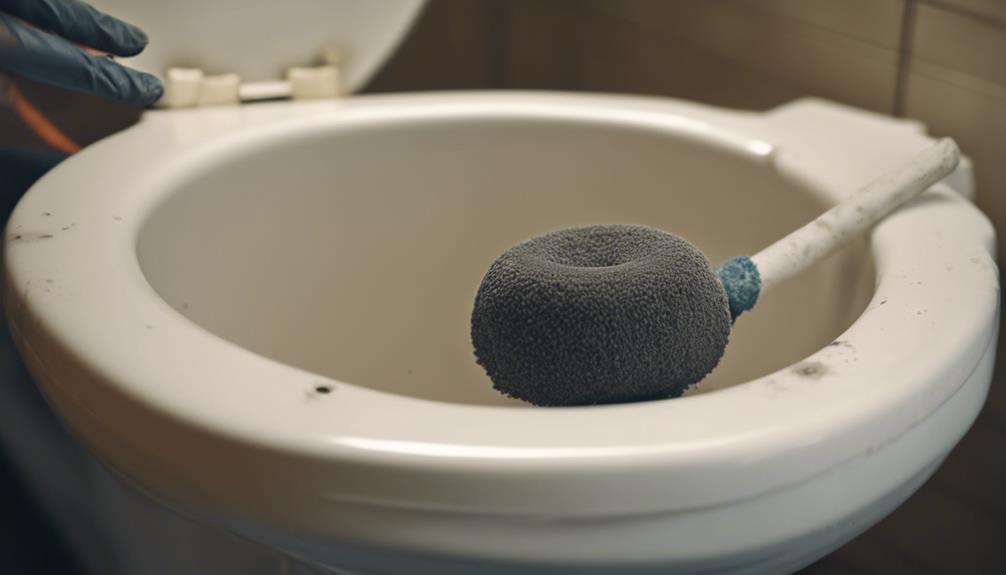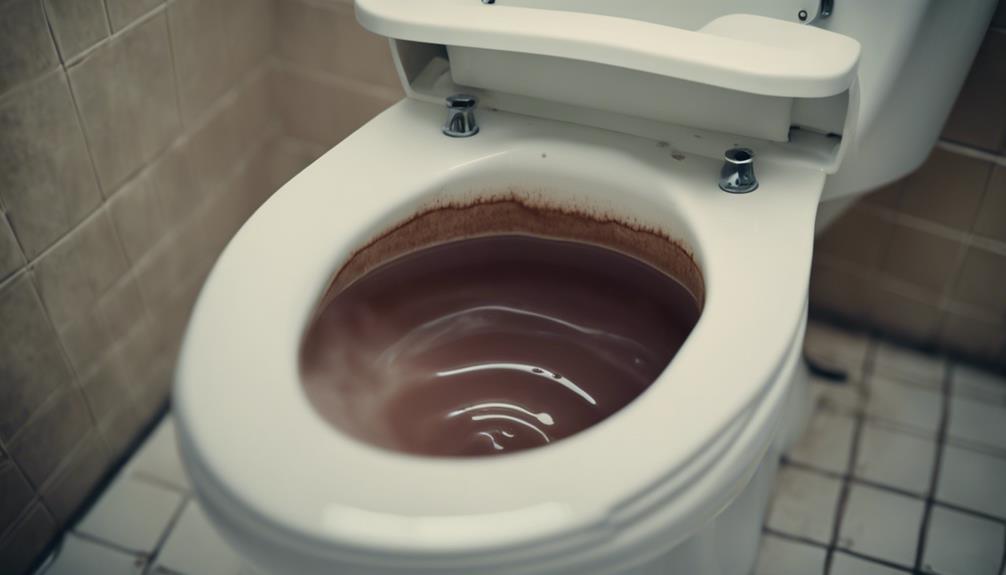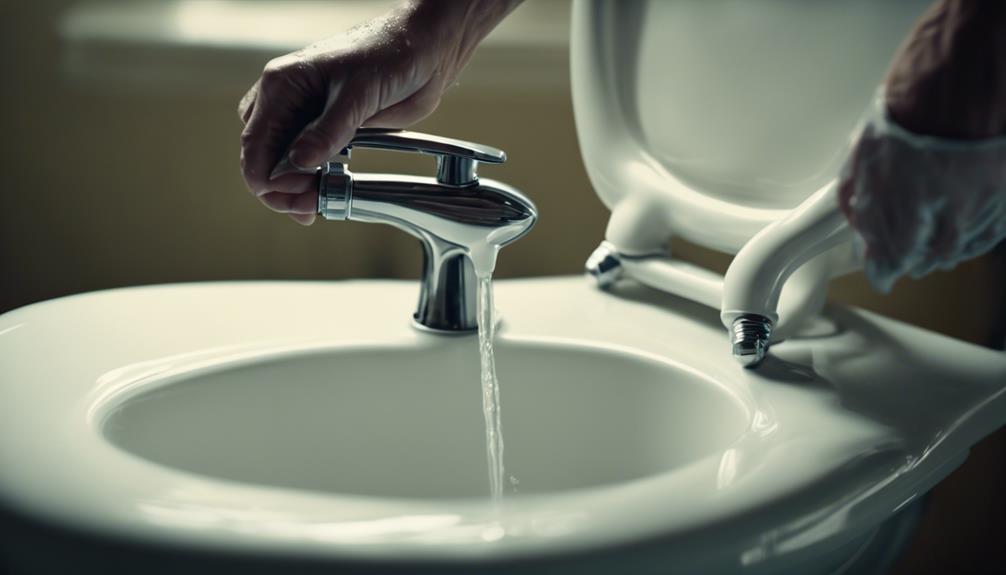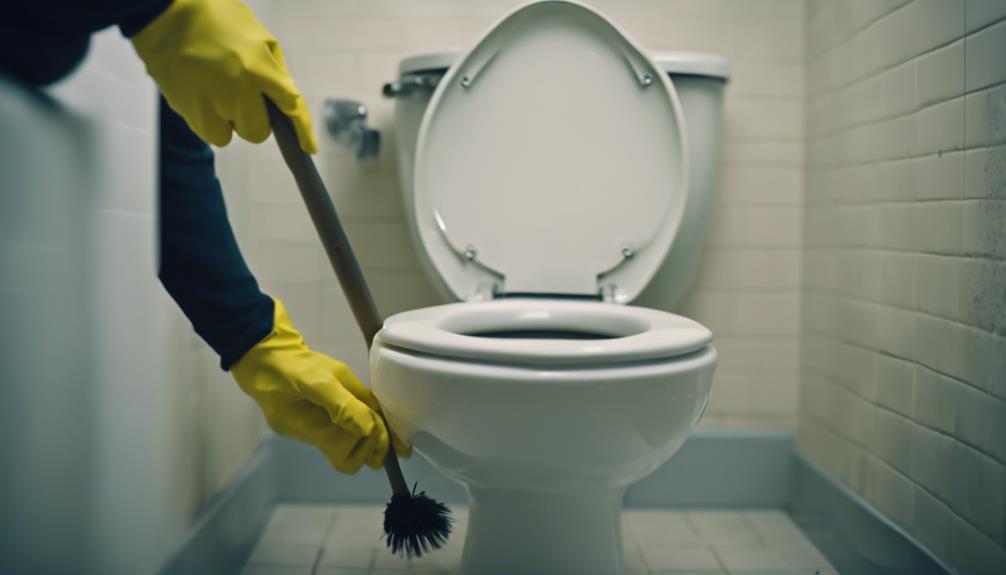To guarantee deep cleaning your toilet bowl, gather a toilet brush, rubber gloves, and cleaner. Target hard water stains with vinegar or lemon juice. Remove calcium buildup using specific cleaning methods or products. Consider undiluted bleach for tough stains. Let the solution sit for at least 5 minutes before scrubbing to tackle stubborn stains effectively. Utilize pumice stones or disinfectant cleaners for deep-seated dirt. Ensure thorough rinsing to prevent residual buildup. By maintaining a sanitized toilet bowl, you'll create a germ-free bathroom environment.
Necessary Cleaning Supplies
To effectively deep clean your toilet bowl, gather the necessary cleaning supplies such as a toilet brush, rubber gloves, scrub sponge, Clorox bleach, and a toilet bowl cleaner.
Rubber gloves are important to protect your hands from the strong chemicals in the cleaning agents. The scrub sponge is a vital tool for tackling tough stains and grime on the toilet bowl surface.
When it comes to disinfecting and whitening, Clorox bleach is a powerful ally in your cleaning arsenal. Additionally, using a specialized toilet bowl cleaner guarantees a thorough cleaning process that eliminates germs and odors effectively.
Removing Hard Water Stains
Consider using vinegar or lemon juice as natural cleaners to effectively remove hard water stains from your toilet bowl. Hard water stains, caused by mineral deposits like calcium and magnesium, can be stubborn but can be tackled with these natural solutions. Simply pour the vinegar or lemon juice into the toilet bowl, ensuring it covers the stained areas. Let it sit for a few hours or overnight for better results. For tougher stains, you can also create a paste with vinegar and baking soda, applying it directly to the stains and scrubbing gently with a toilet brush.
In addition to natural cleaners, pumice stones can be a useful tool for physically removing hard water stains. Wet the pumice stone and gently scrub the stained areas, being careful not to scratch the porcelain surface.
With regular maintenance and cleaning, you can prevent hard water stains from building up in your toilet bowl, keeping it sparkling clean.
Dealing With Calcium Buildup

Dealing with calcium buildup in your toilet bowl requires targeted cleaning methods due to the high mineral content in hard water. Calcium buildup, caused by minerals like calcium and magnesium, can result in unsightly white or brown stains in your toilet bowl over time.
To combat this, consider using specific cleaning products designed to tackle hard water stains effectively. Alternatively, you can opt for natural remedies like white vinegar and baking soda to address lighter calcium buildup issues. These household items can be mixed to create a powerful cleaning solution that helps break down the mineral deposits.
Regular toilet cleaning and maintenance are key in preventing and reducing calcium buildup in your toilet bowl. By incorporating these strategies into your cleaning routine, you can keep your toilet bowl looking clean and free of stubborn calcium deposits.
Using Undiluted Bleach
Harness the powerful cleaning properties of undiluted bleach to effectively tackle tough stains and disinfect your toilet bowl. Undiluted bleach is a potent agent that can deeply clean heavily stained toilets and eliminate harmful bacteria and germs.
When using undiluted bleach, it's important to prioritize safety precautions. Remember to wear gloves to protect your skin and maintain proper ventilation to prevent inhaling fumes.
Before scrubbing, allow the undiluted bleach to sit in the toilet bowl for a few minutes to maximize its cleaning effectiveness. Once the bleach has had time to work its magic, scrub the bowl thoroughly to remove any remaining stains.
After cleaning, make sure to rinse the toilet bowl meticulously to prevent any residual chemical buildup. By following these steps and using undiluted bleach appropriately, you can achieve a sparkling clean and germ-free toilet bowl.
Letting the Solution Sit

To enhance the cleaning effectiveness, allow the solution to sit in the toilet bowl for at least 5 minutes, breaking down stubborn stains and facilitating easier scrubbing. Let it sit and work its magic, ensuring that every nook and cranny gets a thorough treatment. This dwell time is essential for reaching those really deep-seated stains that regular cleaning might miss.
By making sure the solution has enough time to penetrate and dissolve mineral deposits and grime, you set yourself up for success in achieving a sparkling clean toilet bowl.
During this dwell time, the cleaner is actively breaking down the tough stains, making it easier for you when it comes time to scrub. Patience is key here; giving the solution adequate time to work will save you effort in the long run. Remember, the longer you let it sit, the more effective it will be at loosening those stubborn stains.
Scrubbing Stubborn Stains
For tough mineral stains, consider using a pumice stone or Lysol Power bathroom cleaner to scrub the toilet bowl thoroughly. These methods are effective at removing stubborn hard water stains that regular cleaning may not tackle.
When dealing with persistent stains, it's crucial to allow the cleaning solutions to sit for a few minutes before you start scrubbing. This waiting period helps the solution penetrate the stains, making them easier to remove.
In addition to using a pumice stone or powerful bathroom cleaner, you can opt for a disinfecting toilet cleaner to guarantee effective stain removal while also sanitizing the toilet bowl.
Regular maintenance is important in preventing stubborn stains from building up in the toilet bowl. By incorporating these deep cleaning techniques into your toilet cleaning routine, you can keep your toilet bowl looking fresh and stain-free.
Thorough Rinsing Process

Now it's time to guarantee a thorough rinsing process to complete the toilet bowl cleaning.
Flush the toilet several times to wash away any remaining cleaner.
Use a scrubbing brush to make sure all surfaces are well-rinsed and free of any residue.
Flush Toilet Bowl
Begin the deep cleaning process by flushing your toilet bowl to remove any loose debris and prepare it for thorough disinfection. Flushing the toilet bowl guarantees a clean starting point and helps eliminate any particles that may hinder the cleaning process. Make sure the water runs clear before moving on to the next step to prevent diluting the cleaning agents you'll be using.
This initial step of flushing the toilet bowl is essential in setting the stage for a deep and effective cleaning session. By following this standard practice of rinsing the toilet bowl, you're creating the ideal conditions for a successful deep cleaning. Remember, a clear and clean surface is vital for the disinfection process to be as efficient as possible.
Once you have flushed the toilet bowl, you're now ready to proceed with the next steps of the deep cleaning process.
Use Scrubbing Brush
Thoroughly rinse the scrubbing brush after each use to maintain cleanliness and prevent bacteria buildup in your toilet bowl cleaning routine. Using a dedicated scrubbing brush specifically for your toilet bowl is crucial to avoid any cross-contamination with other household surfaces. Make sure the scrubbing brush has sturdy bristles to effectively tackle stains and grime inside the toilet bowl. It's important to regularly replace the scrubbing brush to uphold hygiene standards and prevent the spread of germs in your bathroom.
After each use, rinse the scrubbing brush under hot water to remove any leftover residue and cleaning agents. Allow the brush to air dry completely before storing it away to prevent mold and mildew growth.
Achieving Sparkling Results
To achieve sparkling results when deep cleaning your toilet bowl, make sure you follow the proper cleaning techniques and use effective cleaning products. Start by coating the inside of the toilet bowl with a disinfectant cleaner, scrubbing away any stains, and then flushing after 5 minutes for a thorough clean.
For the exterior of the toilet, use a bathroom disinfecting spray, letting it sit for 10 minutes before wiping it down and applying an extra protection spray for added cleanliness.
When it comes to the toilet seat and lid, utilize a bathroom cleaner to disinfect these surfaces, paying special attention to the flush handle. Wipe it down with a disinfectant wipe in between cleanings to maintain a germ-free environment.
For heavily stained toilet bowls, consider using Clorox bleach, a toilet bowl cleaner with bleach, or undiluted bleach for deep cleaning.
Always follow the specific instructions on your cleaning products to ensure excellent results when deep cleaning and disinfecting your toilet.
Maintaining Sanitized Toilet Bowl

To maintain your toilet bowl sanitized, regularly disinfect the surfaces and prevent bacterial buildup with a reliable cleaner.
By following a routine of disinfection, you can guarantee a germ-free environment in your bathroom.
Remember to stay consistent with your cleaning efforts to uphold a sparkling and sanitized toilet bowl.
Disinfecting Toilet Surfaces
For maintaining a sanitized toilet bowl, it's essential to regularly disinfect all toilet surfaces to eliminate germs and bacteria effectively.
When cleaning your toilet, start by using a disinfectant cleaner specifically formulated for toilet bowls. These cleaners are designed to tackle tough stains, dirt, and grime while disinfecting the surfaces.
Make sure to thoroughly clean all areas of the toilet, including the bowl, seat, lid, and flush handle to ensure thorough disinfection.
Regular disinfection is important for preventing the spread of illnesses and maintaining proper hygiene in your bathroom. Following the manufacturer's instructions on cleaning products is vital to achieve optimal disinfection results.
Preventing Bacterial Buildup
Maintain a sanitized toilet bowl by regularly cleaning to prevent bacterial buildup and guarantee a hygienic bathroom environment.
Bacteria, such as E. coli and Salmonella, can easily thrive in an unclean toilet bowl, posing health risks to household members.
To combat this, it's important to clean and disinfect the toilet bowl using products specifically designed for this purpose. Disinfectant cleaners are effective in killing bacteria and sanitizing the toilet bowl, reducing the spread of germs and ensuring a clean environment.
By following proper cleaning techniques and using the right disinfectant products, you can effectively prevent bacterial growth and maintain a hygienic toilet bowl.
Remember, a clean toilet bowl not only promotes a healthier home but also contributes to a more pleasant bathroom experience for everyone.
Stay proactive in cleaning and sanitizing your toilet bowl to keep harmful bacteria at bay and maintain a germ-free environment in your bathroom.
Conclusion
To sum up, remember that a clean toilet is a happy toilet. Follow these simple steps and your toilet bowl will be sparkling in no time.
As the old saying goes, 'cleanliness is next to godliness,' so take the time to deep clean your toilet bowl regularly to maintain a sanitized and fresh bathroom.
Your future self will thank you for it!